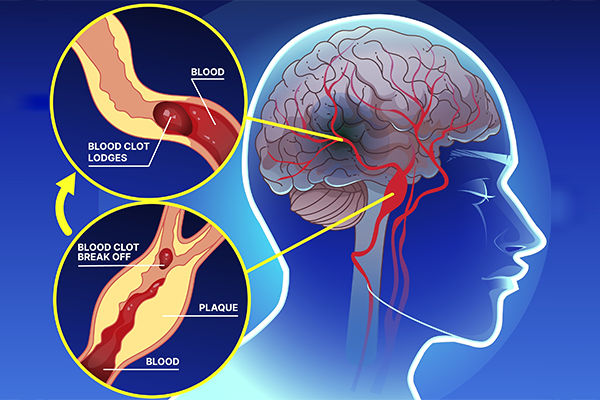
A brain aneurysm is a critical medical emergency that can lead to coma or death if not treated promptly. It helps to fully understand the symptoms of a brain aneurysm, its types, its treatments, including treatment without surgery, and the preventive measures for the same. Such knowledge facilitates prompt medical attention, which can significantly reduce the risks. With the proper care provided by our neurosurgeons in Patiala, the patients have a good chance at recovery.
Synopsis
- What Is a Brain Aneurysm?
- Brain Aneurysm Types
- Brain Aneurysm Symptoms: Recognising the Warning Signs
- Coma After Brain Aneurysm: What Happens and Why?
- Diagnosing Brain Aneurysm and Coma
- Brain Aneurysm Treatment: Saving Lives and Protecting Brain Function
- How to Prevent Brain Aneurysm: Tips for Brain Health
- Recovery and Rehabilitation After Brain Aneurysm and Coma
- Why Choose Neuro Hospital Patiala for Brain Aneurysm Care?
What Is a Brain Aneurysm?
A brain aneurysm refers to a weak area in a blood vessel in the brain that balloons out. This weak area can continue to enlarge over time. When a brain aneurysm ruptures, blood leaks out into the nearby brain tissue, causing a type of brain bleed called subarachnoid haemorrhage. The repercussions can include a stroke, coma, or death.
Brain Aneurysm Types
Saccular (Berry) Aneurysm: The most common type; a sac-like pouch that bulges from an artery wall.
-
Fusiform Aneurysm: Involves the widening of an entire blood vessel.
-
Mycotic Aneurysm: Less common and caused by infection.
-
Dissecting Aneurysm: Caused by a tear in the artery wall layers.
Knowing the type helps our top neurosurgeon in Patiala craft personalised brain aneurysm treatment plans.
Brain Aneurysm Symptoms: Recognising the Warning Signs
Most brain aneurysms remain asymptomatic until they grow large or rupture. Detecting early brain aneurysm symptoms could prevent serious outcomes.
Symptoms Before Rupture (Unruptured Aneurysm)
-
Headache localised behind or above an eye
-
Vision problems, including blurred or double vision
-
Dilated pupils
-
Facial numbness or weakness on one side
-
Seizures in rare cases
Symptoms After Rupture (Ruptured Aneurysm)
-
Sudden, extremely severe headache often described as “the worst headache of my life”
-
Nausea and vomiting
-
Stiff neck
-
Sensitivity to light
-
Loss of consciousness or confusion
-
Seizures
Following rupture, the bleeding increases the intracranial pressure, which can lead to coma, a prolonged state of unconsciousness where the person cannot be awakened.
Coma After Brain Aneurysm: What Happens and Why?
A ruptured brain aneurysm causes blood to leak into the brain tissue or the space around the brain. This bleeding may:
-
Damage brain cells
-
Block normal blood flow and oxygen.
-
Increase pressure inside the skull.
All these effects can impair brain function drastically, leading to a coma.
Severity depends on the volume of bleeding and location. Some patients recover consciousness quickly with treatment, while others remain in a coma for extended periods. Our neurosurgeons in Patiala use established grading systems, like the Hunt and Hess scale, to assess severity and guide brain aneurysm treatment approaches.

Diagnosing Brain Aneurysm and Coma
Early diagnosis is essential to improve survival and reduce disability.
-
Computed Tomographic Angiography (CTA): A CT scan following injection of contrast dye highlights blood vessels and aneurysms.
-
Magnetic Resonance Angiography (MRA): Uses MRI technology to visualise aneurysms without radiation.
-
Digital Subtraction Angiography (DSA): The gold standard involving catheter insertion and dye for detailed imaging of brain vessels.
-
Lumbar Puncture: Testing cerebrospinal fluid for blood helps confirm bleeding in some cases.
For coma diagnosis, clinical tests such as the Glasgow Coma Scale assess eye opening, verbal response, and motor functions to determine coma severity.
Brain Aneurysm Treatment: Saving Lives and Protecting Brain Function
Treatment depends on several factors, including aneurysm size, location, rupture status, and the patient's overall health.
Surgical Treatment
-
Clipping: A neurosurgeon places a metal clip at the aneurysm base to stop blood flow and prevent rupture.
-
Endovascular Coiling: A minimally invasive method where coils are inserted into the aneurysm via a catheter, inducing clotting and isolation from the bloodstream.
Brain Aneurysm Treatment Without Surgery
For some unruptured or small aneurysms, conservative management is preferred. This involves:
-
Close monitoring with regular imaging scans.
-
Blood pressure control to reduce rupture risk.
-
Lifestyle changes, such as smoking cessation and stress management.
-
Avoid heavy physical exertion that may raise blood pressure.
Our expert neurologists and neurosurgeons in Patiala develop tailored non-surgical plans when appropriate.
How to Prevent Brain Aneurysm: Tips for Brain Health
Taking preventive steps can reduce the risk of developing aneurysms or ruptures:
-
Manage Blood Pressure: Keep within healthy ranges through diet, exercise, and medical supervision.
-
Quit Smoking: Smoking weakens blood vessels and raises the risk of aneurysm formation.
-
Eat a Healthy Diet: Focus on fruits, vegetables, lean proteins, and whole grains.
-
Regular Exercise: Helps maintain cardiovascular health.
-
Avoid Excessive Alcohol: Limit intake as it can increase blood pressure.
-
Medical Checkups: Early screening for at-risk individuals, especially those with a family history.
We counsel patients extensively on prevention, promoting lifelong brain health.
Recovery and Rehabilitation After Brain Aneurysm and Coma
Recovery following a ruptured brain aneurysm and coma can be a long and challenging journey. Rehabilitation focuses on:
-
Regaining physical mobility through physiotherapy
-
Speech and occupational therapy to improve communication and daily function
-
Psychological support addressing anxiety, depression, or cognitive changes.
Our team of the best neurosurgeons in Patiala supports patients and families every step, providing hope and tailored care plans.
Why Choose Neuro Hospital Patiala for Brain Aneurysm Care?
At Manipal Hospitals Patiala, patients receive world-class care backed by:
-
Experienced neurosurgeon specialists and neurologists
-
Cutting-edge diagnostic and surgical technology
-
Comprehensive critical care and rehabilitation services
-
Personalised brain aneurysm treatment strategies
-
Compassionate support for patients and caregivers alike
FAQ's
Symptoms can differ, but they commonly involve severe headaches, vision impairment, nausea, neck rigidity, and unconsciousness. Several aneurysms can stay asymptomatic until a rupture occurs.
Saccular (berry), fusiform, mycotic, and dissecting aneurysms are the primary types. All differ in their form and the reason behind their development.
Saccular (berry), fusiform, mycotic, and dissecting aneurysms are the primary types. All differ in their form and the reason behind their development.
If certain mild risk factors are present and the aneurysm is unruptured, then monitoring, blood pressure medication, and lifestyle modifications under expert supervision are possible.
Manage blood pressure, quit smoking, eat healthily, exercise regularly, and have timely medical screenings.
Recovery includes rehabilitation therapies, emotional support, and regular assessments by neurosurgeons and neurologists to improve function and quality of life.





















 6 Min Read
6 Min Read





.png)










